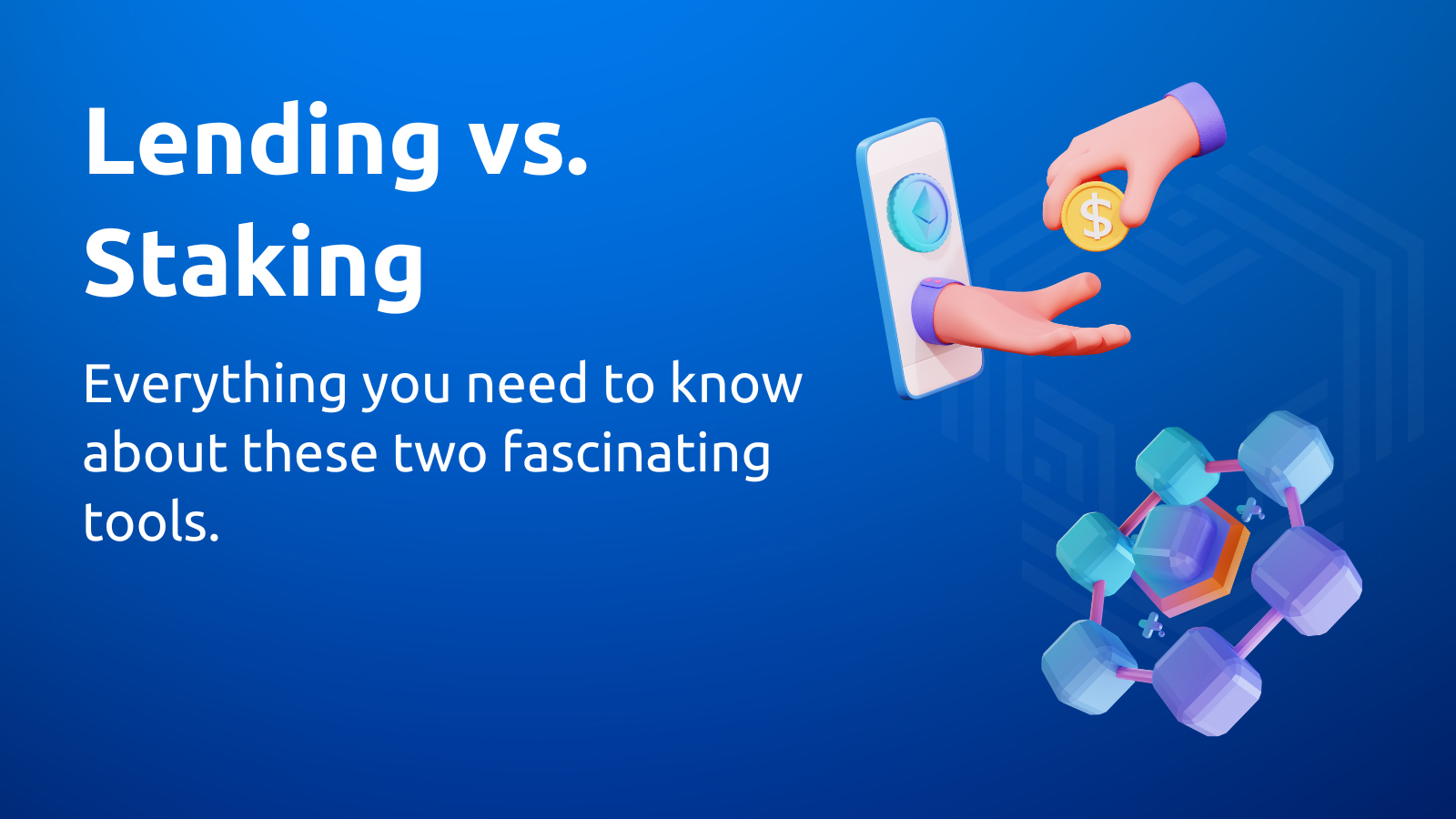When it comes to investing in the cryptocurrency market, there are several strategies to consider. Two popular options are staking and collateralized lending, both offering the potential for significant returns. Staking has a proven record of generating monthly yields, making it an attractive choice for many investors. On the other hand, collateralized lending allows for more flexible terms and higher returns. Understanding the differences between these two strategies can help investors determine which is the better option for their financial goals.
Staking involves holding and “staking” a certain amount of cryptocurrency in a wallet to support the operations of a blockchain network. In return, investors receive rewards, typically in the form of additional coins or tokens. Platforms like KuCoin and Binance allow users to stake their coins and earn yields. Staking is a relatively simple process, and investors can easily find information on the potential yields and requirements for staking their chosen coins.
On the other hand, collateralized lending allows investors to lend their cryptocurrency to others in exchange for interest payments. This strategy involves locking up a certain amount of crypto assets as collateral, which reduces the risk for lenders. Platforms like Coinbase and BlockFi offer collateralized lending services, allowing users to earn interest on their crypto holdings. The terms and interest rates vary depending on the platform and the specific cryptocurrency being borrowed or lent.
Both staking and collateralized lending can be considered safe investments due to the infrastructure and security measures put in place by these platforms. Validators and smart contracts ensure that funds are protected and transactions are secure. However, it is important for investors to do their due diligence and choose platforms with good security scores and transparent financial records.
When deciding between staking and collateralized lending as an investment strategy, investors should consider their financial goals and risk tolerance. Staking offers a reliable source of monthly income, making it suitable for those looking for a steady return. On the other hand, collateralized lending can provide higher annualized yields, but it comes with the risk of default from borrowers. Thorough planning and research are crucial to ensure that the chosen strategy aligns with the investor’s goals and risk appetite.
In conclusion, both staking and collateralized lending have their merits as investment strategies in the cryptocurrency market. Staking provides a simple and secure way to earn monthly yields, while collateralized lending offers higher returns and greater flexibility. Ultimately, the choice between the two will depend on the investor’s financial goals, risk tolerance, and the specific cryptocurrency they want to lend or stake.
Understanding Staking
Staking is a popular investment strategy in the world of cryptocurrency that allows you to earn money by holding and validating transactions on a blockchain network. When you stake your tokens or coins, you lock them up for a certain period of time, during which you contribute to the security and validation of the network.
Of course, the amount you can earn from staking depends on the number of tokens or coins you have and the staking rewards offered by the blockchain network. Some blockchains offer fixed rewards, while others have variable rewards based on factors such as the number of tokens staked and the overall state of the network.
Staking involves some risks, though they are generally lower compared to other investment strategies. One of the biggest risks is related to the security of the network. If the network faces a hacking attack or experiences a technical issue, your staked tokens or coins may be at risk.
Another risk is the volatility of the cryptocurrency market. The value of the coins or tokens you stake can fluctuate, which means that the value of your staked assets may drop. However, staking can also be a way to minimize this risk, as the rewards earned from staking can help offset any potential losses.
One of the advantages of staking is that it allows you to actively participate in the blockchain network and contribute to its security and stability. This is different from traditional banks, where you simply lend your money and earn interest without any involvement in the underlying business.
Staking also offers more flexibility compared to collateralized lending. While collateralized lending requires you to lock in a certain amount of assets as collateral, staking allows you to freely choose the amount of tokens or coins you want to stake. Additionally, staking typically has shorter lock-up periods compared to collateralized lending, which means that you can access your staked assets more quickly if needed.
Choosing the best investment strategy between staking and collateralized lending depends on your personal preferences and risk tolerance. Staking is generally considered a safer option, as it involves contributing to the security and validation of the blockchain network. However, collateralized lending can offer higher potential profits, especially during times of market volatility.
Before you start staking, it’s important to do your research and understand the specific rules and risks associated with the blockchain network you plan to stake on. Make sure to choose a trusted staking platform or wallet that supports the specific blockchain you want to stake on, and consider diversification to spread out the risks.
Understanding Collateralized Lending
Collateralized lending is a financial strategy where borrowers provide assets as collateral to secure a loan. The lender then holds these assets until the borrower repays the loan. This type of lending allows borrowers to access funds while still retaining ownership of their assets.
For example, let’s say a borrower wants to borrow $10,000. They can offer their cryptocurrency holdings as collateral to receive the loan. Once the loan is repaid, the borrower gets their assets back. If the borrower defaults on the loan, the lender can sell the collateral to recover their funds.
Collateralized lending is considered a safer investment strategy compared to other forms of lending because the collateral provides a level of security. Even if the borrower defaults, the lender can still recover their funds by selling the collateral.
One of the key advantages of collateralized lending is that it allows investors to earn passive income through interest rates. Lenders earn interest by lending out their assets, and borrowers pay interest on the loans they receive. This creates a win-win situation where lenders can make profits and borrowers have access to funds.
There are various platforms and technologies available that enable collateralized lending, such as Crypto.com and Coinbase. These platforms provide user-friendly interfaces for both lenders and borrowers to participate in the lending process. Lenders can choose the amount of assets they want to lend and set the interest rate they desire, while borrowers can select the loan amount and the length of the loan term.
Before engaging in collateralized lending, it’s important to understand the risks involved. The value of the assets used as collateral can fluctuate, so lenders should be aware that their funds may be at risk if the value of the collateral drops significantly. Additionally, there is the risk of default if the borrower is unable to repay the loan. It is crucial to thoroughly research and choose reliable platforms and borrowers to mitigate these risks.
In summary, collateralized lending is a strategy that allows borrowers to access funds by providing assets as collateral. Lenders can earn passive income through interest rates, while borrowers can get the funds they need. However, it is important to fully understand the risks involved and choose reliable platforms before participating in collateralized lending.
Benefits of Staking
Staking has emerged as a popular investment strategy in the cryptocurrency space due to its numerous benefits. Compared to collateralized lending, staking offers several advantages that make it a favorable choice for investors.
1. Passive Income:
Staking allows users to earn passive income by holding their cryptocurrencies in a staking account rather than keeping them in a regular wallet. By staking, users can actively participate in the network and receive rewards for validating transactions.
2. Lower Risks:
When staking, the funds are usually locked in a smart contract or held in a designated staking account, reducing the risk of loss or theft compared to collateralized lending. The staked coins remain in the user’s possession, allowing greater control and security.
3. Simplicity and Accessibility:
Staking is a relatively straightforward process that can be done directly through a compatible wallet or on staking platforms available on exchanges such as Coinbase, Binance, and Kucoin. This accessibility makes staking a viable option for both experienced and novice users.
4. Long-Term Value Generation:
Staking provides an opportunity for long-term investors to generate additional income by holding onto their staked coins. While collateralized lending involves short-term loans, staking rewards can accumulate over time, potentially resulting in significant returns.
5. Network Participation:

By staking their coins, individuals actively participate in the network and contribute to its security and decentralization. This involvement helps to strengthen the infrastructure and overall stability of the crypto project.
6. Flexibility in Terms:

Staking offers greater flexibility in terms compared to collateralized lending. Users can choose the duration of their staking period, the amount of coins to stake, and often have the option to unstake or withdraw their funds at any time, subject to specific terms.
7. Potential for Higher Annualized Returns:
In some cases, staking can yield higher annualized returns compared to collateralized lending. The rewards received from validating transactions can be substantial, especially when staking on networks with higher utilization and demand.
In conclusion, staking provides a variety of benefits that make it an attractive investment strategy. It offers passive income, lower risks, simplicity and accessibility, long-term value generation, network participation, flexibility in terms, and the potential for higher annualized returns. By staking their coins, investors can actively contribute to the network while earning rewards for their participation.
Benefits of Collateralized Lending
Collateralized lending offers several benefits to investors looking for a secure and potentially profitable investment strategy.
1. Secure funding
By providing collateral, such as digital assets or fiat currency, lenders have added security in the event of default by the borrower. This makes collateralized lending a safer option compared to other investment strategies.
2. Higher interest rates
Collateralized lending often offers higher interest rates compared to traditional savings accounts and other investment options. This allows investors to generate a higher return on their investment.
3. Diversification
With collateralized lending, investors have the opportunity to diversify their portfolio by lending different types of assets to various borrowers. This diversification can help balance the risks and potentially increase profits.
4. Increased borrowing power
Collateralized lending allows individuals to borrow a larger amount of money than they would typically be eligible for through traditional lending methods. The amount that can be borrowed is determined by the value of the collateral provided.
5. Flexibility
Collateralized lending offers flexibility in terms of loan terms and repayment schedules, allowing borrowers to choose the options that best suit their needs. This flexibility can be especially beneficial in times of financial instability.
6. Potential for margin trading
In some cases, collateralized lending can provide borrowers with the ability to engage in margin trading, allowing them to amplify their trading positions and potentially generate higher profits.
7. Passive income
Collateralized lending enables individuals to earn passive income by lending their assets to borrowers. This income can be particularly appealing to those who want to grow their wealth without actively participating in trading or other investment activities.
Risks of Staking
Staking is a popular method for earning passive income in the cryptocurrency world. However, like any investment strategy, it comes with its own set of risks and considerations.
1. Protocol Risks
When staking, you are entrusting your funds to a specific protocol or network. It is important to thoroughly research and understand the chosen protocol’s technology, security measures, and overall reliability. Ensure that the protocol has been audited or reviewed by trusted third-party sources, and stay updated with any news or information regarding potential vulnerabilities or exploits.
2. Centralization Risks
While staking can offer attractive rewards, some protocols may have a centralized structure. This means that a select few entities or individuals control a significant portion of the network’s staking power. If these entities act maliciously or make poor decisions, it can affect the overall stability and security of the network.
3. Platform Risks

When staking on an exchange or platform, there are additional risks to consider. For example, if the exchange you have chosen for staking experiences a security breach, your funds could be at risk. Make sure to use established and reputable exchanges like Kraken, and research their security measures and track record before depositing your funds.
4. Lack of Liquidity
When you stake your crypto, it becomes tied up and locked for a certain period. This lack of liquidity can be problematic if you suddenly need access to your funds or if the market experiences a significant downturn. Assess your own financial needs and the potential risks before choosing to stake a large amount of your cryptocurrency.
5. Inflation Risks
Staking usually involves earning rewards in the form of additional tokens. However, this can lead to inflation if the supply of tokens being rewarded is not properly managed. Be mindful of the inflation rate of the staking protocol and how it may impact the long-term value of your staked assets.
6. Technology Risks
New protocols and technologies are constantly emerging in the crypto space. While they may promise innovative features or higher returns, it is important to carefully evaluate their credibility and reliability. Beware of overly complex or untested technologies, as they may pose a higher risk of bugs, security vulnerabilities, or even exit scams.
7. Regulatory Risks
The regulatory landscape for cryptocurrencies is still evolving in many jurisdictions. It is important to stay informed about any changes in regulations that may impact staking activities. Non-compliance with regulatory requirements could result in legal issues, fines, or loss of funds.
Overall, staking can be a lucrative investment strategy, but it is crucial to research, assess risks, and make informed decisions. Diversifying your investment portfolio and considering other strategies, such as collateralized lending, can help mitigate some of the risks associated with staking.
Risks of Collateralized Lending
Collateralized lending, as the name suggests, involves using an asset as collateral to secure a loan. In the case of cryptocurrency, this could be a specific amount of a particular cryptocurrency held in a wallet. However, it is important to consider the risks associated with this investment strategy.
1. Asset volatility: Cryptocurrencies are known for their price volatility. The value of the collateralized asset can change rapidly and significantly, potentially putting the lender at risk of receiving a collateral that is worth less than the loaned amount.
2. Counterparty risk: When engaging in collateralized lending, there is a counterparty involved – the borrower. There is always the risk that the borrower may default on the loan, either by not repaying it or not providing the collateral as agreed upon.
3. Market liquidity: The ability to quickly sell or liquidate the collateralized asset may be limited, particularly in situations of market downturns or low trading volumes. This can pose challenges if the lender needs to retrieve their funds quickly.
4. Information asymmetry: Lenders may not have access to all the necessary information about the borrower, the collateral, or the overall market conditions. This lack of information can make it difficult to accurately assess the risks involved in the lending transaction.
5. Regulatory and legal risks: The cryptocurrency space is still relatively young and regulatory frameworks are constantly evolving. There may be legal uncertainties or restrictions on collateralized lending activities depending on the jurisdiction, which can introduce additional risks for both lenders and borrowers.
Overall, while collateralized lending can offer opportunities for earning interest on idle cryptocurrency holdings, it is essential for investors to carefully evaluate the risks before engaging in such strategies.
Comparing Returns
When it comes to comparing the returns of staking and collateralized lending, it’s important to understand how each strategy works and what kind of returns they can offer.
Staking is a popular investment strategy in the digital currency space, where investors secure and validate transactions on a blockchain network. In return, they receive rewards in the form of additional coins. Staking can be a very profitable strategy, especially if you stake popular coins like Bitcoin or Ethereum. However, there is a risk of network defaults, where you may not receive the promised rewards if the network fails.
On the other hand, collateralized lending allows you to lend your digital assets to other users in exchange for interest. This can be a safer strategy compared to staking, as you have collateral backing up the loan. For example, on platforms like KuCoin or Kraken, you can lend your coins to traders who need them for margin trading or short selling. You charge an interest rate for the borrowed funds, and if the borrower defaults, you can sell their collateral to recover your investment.
Both staking and collateralized lending can offer significant returns, but they have different risk profiles. Staking is more suitable for those who believe in the future value of the coins they’re staking and are willing to take the risk of potential defaults. Collateralized lending, on the other hand, is a safer option as it involves collateral that can be sold in case of default. It’s important to do thorough research and understand the risks and returns associated with each strategy before deciding which one to pursue.
For more information on staking and collateralized lending, you can check out the sources below:
- Source 1: “A Comprehensive Guide to Staking” – a detailed guide on staking and its benefits.
- Source 2: “Collateralized Lending: The Safer Investment Strategy?” – an analysis of collateralized lending compared to other investment options.
- Source 3: “Staking vs. Collateralized Lending: Which is Right for You?” – a comparison of the pros and cons of staking and collateralized lending.
Factors to Consider
When comparing staking and collateralized lending as investment strategies, there are several factors to consider.
1. Risk:
Both staking and collateralized lending involve risks, but the level of risk can vary. Staking typically carries less risk, as it involves locking up a certain amount of cryptocurrency in a wallet. On the other hand, collateralized lending involves using the cryptocurrency as collateral for a loan, which comes with higher risks, such as fluctuating interest rates and potential default by borrowers.
2. Returns:
The potential returns on staking and collateralized lending can vary as well. Staking usually provides a fixed annualized return, while the returns from collateralized lending depend on factors such as loan terms and interest rates. It’s important to consider the potential returns before deciding which investment strategy to pursue.
3. Custodian of Funds:
In staking, you generally keep custody of your cryptocurrency assets in a wallet. This gives you control over your funds, but also means you are responsible for their security. Collateralized lending may involve using an online platform or financial institution as a custodian for your funds, which provides added security but also means giving up control over the assets.
4. Long-term Planning:
Staking is often seen as a long-term investment strategy, as the staked cryptocurrency is locked up for a certain period of time. Collateralized lending, on the other hand, allows for more flexibility, as borrowers can choose the loan terms that suit their needs. Consider your long-term investment goals and choose the strategy that aligns with them.
In conclusion, both staking and collateralized lending have their advantages and disadvantages. It’s important to assess your risk tolerance, desired returns, and long-term investment goals before deciding which strategy is right for you. Understanding the risks and processes involved in each strategy will help you make an informed decision and maximize your investment potential.
Frequently Asked Questions:
What is staking?
Staking is the process of holding and validating cryptocurrency in a proof-of-stake network to support the network’s operations and earn rewards.
How does collateralized lending work?
Collateralized lending is a process where borrowers provide collateral, such as cryptocurrency, to lenders in order to secure a loan. If the borrower fails to repay the loan, the lender can seize the collateral.
Which investment strategy is considered better: staking or collateralized lending?
The better investment strategy, whether staking or collateralized lending, depends on various factors such as the individual’s risk tolerance, the cryptocurrency being used, and market conditions. Both strategies have their own benefits and risks.
What are the risks associated with staking?
Some of the risks associated with staking include the possibility of slashing, where a portion of the staked cryptocurrency is lost due to malicious or negligent behavior, and the risk of market volatility, which can cause the value of the staked cryptocurrency to decrease.
What are the risks associated with collateralized lending?
The risks of collateralized lending include the potential for default by the borrower, which could result in the loss of the collateral, and the risk of market volatility, which can affect the value of the collateral and the borrower’s ability to repay the loan.
Can staking and collateralized lending be combined as an investment strategy?
Yes, staking and collateralized lending can be combined as an investment strategy. Some platforms allow users to stake their cryptocurrency while also using it as collateral for loans, providing the opportunity to earn staking rewards and interest from lending simultaneously.
Video:
Best Avalanche Staking Methods – a Comparison of Earning Strategies With Your AVAX (How to Stake)



I believe staking is the better investment strategy. With staking, I can earn monthly yields and support the operations of a blockchain network. It’s a win-win situation!
I personally believe that staking is the better investment strategy. With staking, I can earn monthly yields without having to worry about lending my cryptocurrency to others. It’s a simpler and more straightforward process, and it allows me to support the blockchain network and earn rewards at the same time.
Staking seems like the better investment strategy to me. It provides monthly yields and is relatively easy to understand and participate in. Plus, platforms like KuCoin and Binance make it convenient to stake your coins and earn rewards. Collateralized lending may offer higher returns, but it also carries more risks and requires locking up your crypto for a period of time. Staking offers a balance of profitability and simplicity, which makes it my preferred choice in the cryptocurrency market.
Staking is definitely the better investment strategy for me. I love the idea of earning monthly yields and it’s great that platforms like KuCoin and Binance make it so easy to stake my coins and earn rewards. Plus, it’s a relatively simple process with clear information on potential yields. Staking all the way!
Collateralized lending seems like a more profitable option to me. With flexible terms and higher returns, it offers a great opportunity for investors to earn passive income. Staking may be simpler, but it doesn’t provide the same level of potential gains. I’ll definitely be considering collateralized lending for my investment strategy.
Can you explain how the potential returns of staking and collateralized lending differ? Which strategy typically offers higher returns?
Hi Alexandra1987! When comparing the potential returns of staking and collateralized lending, it’s important to consider the factors that contribute to each strategy.
As an experienced investor, I believe that staking is the better investment strategy. The monthly yields generated with staking make it a consistent and attractive choice. Plus, platforms like KuCoin and Binance provide transparent information on potential yields and requirements, making it easy for investors to make informed decisions. Collateralized lending may offer higher returns, but the lack of flexibility and additional risks make staking a more reliable option.